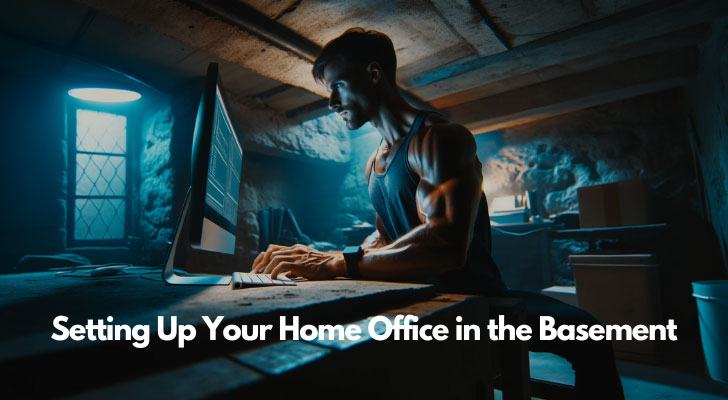So you've chosen the basement as your new home office spot? Smart move. It's away from the hustle and bustle of daily life, giving you that much-needed peace to focus. But hey, there's more to a home office than just a solid internet connection. Let's check out how you can make your basement workspace both comfortable and healthy.
Did You Know?
- Percentage of New Homes with Basements: About 30% of new homes built in the United States include basements, according to the U.S. Census Bureau.
- Basement Remodeling ROI: Homeowners can expect an average return on investment (ROI) of about 70-75% for basement remodeling projects, as reported by Remodeling Magazine's Cost vs. Value Report.
- Cost per Square Foot: The average cost of finishing a basement can range from $25 to $50 per square foot, depending on the finishes and location.
- Additional Living Space: Finished basements can increase living space by 50-100%, particularly in homes where the basement footprint matches the main floor.
- Home Office Use: Around 15% of basements are used as home offices or for running a business from home.
Working In The Basement Pros and Cons
First of all, let's find out the upsides and downsides without getting too fancy or wrapping it up with a bow at the end.
Pros:
- Privacy: You'll have your own cozy space. It's like your little island where you can focus without someone always popping in to chat. Nice for those deep work sessions, huh?
- Cool and Quiet: Basements are naturally cooler and quieter. This means during those hot summer months, you've got a chill spot without cranking up the AC. Plus, the reduced noise is a bonus for concentration or if you're on calls a lot.
- Space Flexibility: You've got room to play with. Whether you want a desk, a couple of monitors, or even a small lounge area, you can probably fit it. This space can morph into whatever you need it to be.
- Cost-Effective: By using space you already have, you're saving cash on renting an office or coworking space. Plus, the commute is unbeatable. Just a quick trip down the stairs, and you're there.
Cons:
- Isolation: While privacy is great, too much of it can feel isolating. If you're someone who gets energy from being around others, the basement might start to feel like a bit of a cave.
- Lighting Challenges: Basements aren't exactly known for their abundance of natural light. You might find yourself missing the sunshine, and over time, poor lighting can strain your eyes.
- Moisture and Ventilation: Basements can be damp. This isn't just a comfort issue; it can also lead to problems with your equipment. Plus, without good ventilation, air quality can dip, making it less than ideal for long hours.
- Distractions: Even though it's separate, home distractions are still a thing. There's always a risk of the home-life boundary blurring. You might find yourself taking "quick breaks" to do laundry or dishes, which can eat into productivity.
Light It Up Right
Basements aren't exactly known for their abundance of natural light, right? Good lighting is crucial, not just for seeing what you're doing, but for your mood and eye health too. Here are a couple of tips:
Use Layered Lighting
Combine general, task, and accent lighting. Overhead lights for overall brightness, desk lamps for focused work, and maybe a few accent lights to keep things cheerful. Here's why it matters:
- Avoids Eye Strain and Fatigue: Relying solely on a single, harsh overhead light can cause eye strain. A mix of ambient, task, and accent lighting reduces the contrast between the light on your workspace and the surrounding area, making it easier on your eyes.
- Boosts Mood and Productivity: Different tasks require different kinds of lighting. For instance, a bright desk lamp is great for reading or writing, while softer, ambient lighting works well for video calls or creative brainstorming. By having the flexibility to adjust your lighting based on what you're doing, you can stay more focused and in a better mood.
- Enhances Aesthetics and Comfort: Layered lighting also helps in making your basement office feel more inviting and comfortable. It can transform the space from feeling like just a 'basement' into a warm, welcoming workspace.
Did You Know?
- Rental Income Potential: Approximately 20% of homeowners with finished basements rent them out, generating an average of $1,000 in rental income per month.
- Increase in Home Value: Finishing a basement can increase a home's overall value by 10-20%, depending on the market and the quality of the finish.
- Popularity Among Homebuyers: 85% of homebuyers consider a finished basement to be a desirable or essential feature, according to a survey by the National Association of Home Builders.
- Energy Efficiency: Basements have the potential to be 10-20% more energy-efficient than above-ground levels due to natural insulation from the earth.
- Moisture Problems: Up to 60% of basements have chronic moisture problems, necessitating careful moisture control strategies.
Mimic Natural Light
If natural light is scant, go for LED bulbs that mimic daylight. They can help keep your circadian rhythm in check and fight off that groggy feeling.
- Maintains Circadian Rhythm: Natural light has a significant impact on our circadian rhythms – our internal clock that tells us when to feel awake or sleepy. In a basement without natural light, using artificial lights that mimic the color temperature of daylight helps keep your circadian rhythm in check, reducing feelings of fatigue or lethargy.
- Reduces Melatonin Suppression: Exposure to light that mimics daylight can reduce the production of melatonin (the sleep hormone) during the day, keeping you more alert and awake. This is particularly vital in a basement office where exposure to natural light is limited.
- Improves Mental Health: Studies have shown that exposure to natural light (or light that mimics it) can improve mood and even reduce the effects of Seasonal Affective Disorder (SAD). This is especially crucial during the darker months.
If your basement office doesn't have these lighting setups, you might run into a few problems:
- Increased Eye Strain and Discomfort: Poor lighting can lead to squinting, headaches, and a higher risk of long-term eye problems.
- Disrupted Sleep Patterns: Without light that mimics natural daylight, your body might struggle to maintain a normal sleep-wake cycle, leading to potential sleep issues.
- Lower Productivity and Mood Swings: Inadequate lighting can make you feel more tired, less motivated, and even impact your mental well-being.
Getting Your Basement Online
Now, let's walk through how you can get your cozy basement spot hooked up to the world wide web. It's not rocket science, but it does need a bit of know-how. Wired connections, like Ethernet, are usually more reliable and faster.
Wireless options might be easier to set up but can struggle with signal strength, especially through floors and walls.
Going Wired: Running an Ethernet Cable
If you're leaning towards a wired connection, you'll need to run an Ethernet cable from your router to your basement workspace. It's a bit of physical work, but the payoff is a stable and fast internet connection. Here's a quick breakdown:
- Locate Your Router: Find where your main internet router is in your house. It's usually where your internet service enters your home.
- Plan Your Route: Think about the best way to run the cable from the router to your basement. Avoid places where the cable could be a tripping hazard or get damaged.
- Measure the Distance: Measure how long your Ethernet cable needs to be. It's better to overestimate a bit than to fall short.
- Buy the Right Cable: Ethernet cables come in different categories (Cat5e, Cat6, Cat6a, etc.). For most home uses, Cat5e or Cat6 will do the trick.
- Running the Cable: Now, the fun part. You might need to drill through floors or walls. Be sure to check for any electrical wiring or plumbing before drilling. Run the cable through the holes and secure it along the way with cable clips.
- Connect and Test: Plug one end of the cable into your router and the other into your computer or a WiFi extender if you need wireless in your basement. Test your connection to make sure it’s working smoothly.
Wireless Options: Extenders and Mesh Networks
If running a cable sounds like a hassle, consider wireless options. WiFi extenders or mesh network systems can help boost the signal to your basement. Here’s a quick look:
- WiFi Extenders: These devices capture your existing WiFi signal and rebroadcast it. Place one on the floor above your basement, ideally in a spot where it still gets a good signal from your router.
- Mesh Networks: A bit more advanced (and pricier) but super effective. Mesh systems use multiple router-like devices placed around your home to create a seamless WiFi network. One of these nodes can be placed near your basement to ensure good coverage.
Tips for Success
- Check for Interference: Other devices like microwaves and cordless phones can mess with your signal. Keep your router or WiFi extenders away from these.
- Update Your Equipment: If your router is old, it might be time for an upgrade to ensure better coverage and speeds.
- Secure Your Network: Always use a strong, unique password for your WiFi. You don’t want neighbors mooching off your internet!
Did You Know?
- Use for Entertainment: Nearly 40% of finished basements are used primarily as entertainment spaces, such as home theaters or game rooms.
- Gym and Exercise Space: About 25% of homeowners with finished basements use them as a space for exercise or a home gym.
- Storage Solutions: Despite renovations, 75% of basements still serve as a primary storage area for households.
- Telecommuting Increase: With a rise in telecommuting, there's been a 30% increase in the number of basements being converted into workspaces post-2020.
- Soundproofing Investments: Homeowners spend an average of $1,500 to $2,500 on soundproofing basement ceilings in homes where the basement is used as a living space or rental unit.
Ergonomics: Your Back Will Thank You
Sitting for hours can be tough on your body. Investing in ergonomics can save you from a lot of aches and pains down the line.
- Chair and Desk: Get a chair that supports your back well and can be adjusted to your height. Pair it with a desk at a comfortable height, or consider a standing desk.
- Monitor Setup: Position your monitor so the top of the screen is at or slightly below eye level. This helps in reducing neck strain.
- Keyboard and Mouse: They should be placed in a way that keeps your wrists straight to avoid strain.
Air Quality and Temperature
Basements can get stuffy and cold (or sometimes too warm). Maintaining good air quality and a comfortable temperature is vital.
- Air Circulation: If your basement doesn't have windows, consider using a fan or an air purifier to keep the air fresh.
- Humidity Control: Basements can be damp. A dehumidifier can help prevent mold and make the air more comfortable.
- Temperature Control: Space heaters or fans can help regulate the temperature. Just be sure to use them safely!
Did You Know?
- Permitting and Regulation: Approximately 90% of basement remodeling projects require a permit, with costs varying by location.
- Flood Risk Awareness: 98% of basements in the U.S. will experience some form of water damage during their lifespan, emphasizing the importance of waterproofing measures.
- Children's Play Area: Over 30% of basements are utilized as play areas for children, providing a safe and contained environment indoors.
- Accessibility Modifications: Around 5% of basement renovations include accessibility modifications for older adults or those with disabilities.
- Increase in DIY Projects: There has been a 25% increase in DIY basement projects since 2019, fueled by online tutorials and home improvement platforms.
Personalize Your Space
Your workspace should make you feel good. Add a personal touch!
- Decor: Hang up some art, bring in some plants (there are plenty that thrive in low light), or display some personal items that make you smile.
- Organize: Keep your space tidy with good storage solutions. Shelves, filing cabinets, or even decorative boxes can keep clutter at bay and your mind clear.
Health Considerations
Spending a lot of time in your basement office means you should consider your health too.
- Take Regular Breaks: Every hour, get up, stretch, or take a brief walk. It helps with circulation and prevents stiffness.
- Stay Hydrated and Snack Smart: Keep water nearby and choose healthy snacks. It's easy to forget to eat and drink when you're focused.
- Eye Care: Follow the 20-20-20 rule. Every 20 minutes, look at something 20 feet away for 20 seconds to reduce eye strain.
Setting up your basement home office is an exciting project. With the right setup, it can be a wonderful space where you're productive and comfortable. It’s all about creating a space that works for you, both in terms of function and comfort. Happy office planning!
How I "Finally" Make Over $7,000 Monthly Income
"The most valuable thing I've ever done!"






You need an electrician to do wiring because all the damp in the basement you don’t want your amateur technique to apply then get electricuted. Plus Wifi setup is the hardest part, you need to bring the ethernet cable down so at least you get the signal at the basement level.
Thank you for your article,=, it was incredibly useful cos I’m in the process of transforming my basement into a workspace.
It’s a bit of a challenge since there’s no electricity down there at the moment.
Your tips have given me a good starting point and the confidence. I need decluttering to start with. With your post, I especially appreciated about the lighting and power alternatives. The use of natural light and portable power sources are great idea for me. I’m willing to try whatever it takes. I’ll see how they enhance my basement workspace.
Your step-by-step guide makes things much more manageable, and I’m excited to try it out. Thanks again for sharing your insights. They’ll definitely come in handy.